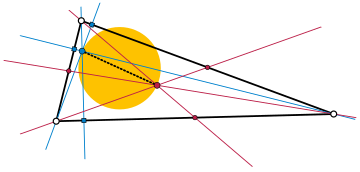

In geometry, the orthocentroidal circle of a non-equilateral triangle is the circle that has the triangle's orthocenter and centroid at opposite ends of its diameter. This diameter also contains the triangle's nine-point center and is a subset of the Euler line, which also contains the circumcenter outside the orthocentroidal circle.
Andrew Guinand showed in 1984 that the triangle's incenter must lie in the interior of the orthocentroidal circle, but not coinciding with the nine-point center; that is, it must fall in the open orthocentroidal disk punctured at the nine-point center. The incenter could be any such point, depending on the specific triangle having that particular orthocentroidal disk.
Furthermore, the Fermat point, the Gergonne point, and the symmedian point are in the open orthocentroidal disk punctured at its own center (and could be at any point therein), while the second Fermat point and Feuerbach point are in the exterior of the orthocentroidal circle. The set of potential locations of one or the other of the Brocard points is also the open orthocentroidal disk.
The square of the diameter of the orthocentroidal circle is where a, b, and c are the triangle's side lengths and D is the diameter of its circumcircle.
References
- Guinand, Andrew P. (1984), "Euler lines, tritangent centers, and their triangles", American Mathematical Monthly, 91 (5): 290–300, doi:10.2307/2322671, JSTOR 2322671.
- ^ Bradley, Christopher J.; Smith, Geoff C. (2006), "The locations of triangle centers", Forum Geometricorum, 6: 57–70.
- ^ Stern, Joseph (2007), "Euler's triangle determination problem" (PDF), Forum Geometricorum, 7: 1–9.
- Franzsen, William N. (2011), "The distance from the incenter to the Euler line", Forum Geometricorum, 11: 231–236.
- Leversha, Gerry; Smith, G. C. (November 2007), "Euler and triangle geometry", Mathematical Gazette, 91 (522): 436–452, doi:10.1017/S0025557200182087, JSTOR 40378417, S2CID 125341434.
- Bradley, Christopher J.; Smith, Geoff C. (2006), "The locations of the Brocard points", Forum Geometricorum, 6: 71–77.
- Altshiller-Court, Nathan, College Geometry, Dover Publications, 2007 (orig. Barnes & Noble 1952).
External links
 Media related to Orthocentroidal circle at Wikimedia Commons
Media related to Orthocentroidal circle at Wikimedia Commons
 where a, b, and c are the triangle's side lengths and D is the diameter of its
where a, b, and c are the triangle's side lengths and D is the diameter of its